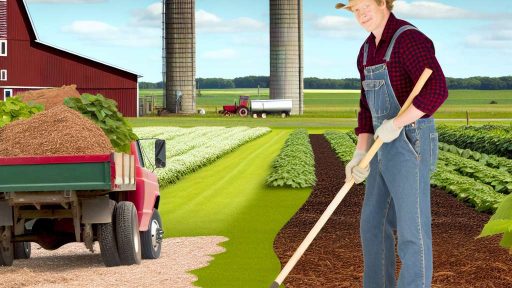Introduction to Organic Weed Control in Sustainable Farming
Organic weed control plays a vital role in sustainable farming practices.
This approach eliminates the need for synthetic chemicals.
Farmers focus on maintaining healthy ecosystems.
Effective weed management promotes soil health and crop yields.
Understanding Weeds and Their Impact
Weeds compete with crops for nutrients, water, and sunlight.
They can reduce crop yields and lower food quality.
Moreover, weeds may harbor pests and diseases.
Thus, managing weeds is essential for optimal farming results.
Benefits of Organic Weed Control
Organic methods protect the environment and human health.
They enhance biodiversity by supporting beneficial organisms.
Additionally, these practices improve soil fertility.
Farmers can achieve sustainable yields without chemicals.
Common Organic Weed Control Methods
Farmers use various techniques to manage weeds organically.
- Cultivation and tillage effectively disrupt root systems.
- Mulching suppresses weed growth by blocking sunlight.
- Cover cropping improves soil health and outcompetes weeds.
- Hand weeding remains a labor-intensive but effective method.
- Natural herbicides, such as vinegar, can be applied carefully.
Integrating Strategies for Success
Combining multiple methods maximizes effectiveness.
Farmers may choose to rotate crops to disrupt weed cycles.
Transform Your Agribusiness
Unlock your farm's potential with expert advice tailored to your needs. Get actionable steps that drive real results.
Get StartedFurthermore, applying timely actions improves results.
Regular monitoring helps identify weed problems early.
Importance of Organic Weed Control in Agricultural Practices
Promoting Soil Health
Organic weed control enhances soil health significantly.
It fosters a diverse ecosystem within the soil.
This diversity improves the soil structure and fertility.
Healthy soil supports robust crop growth.
Moreover, it helps retain moisture and nutrients effectively.
Minimizing Chemical Exposure
Organic methods reduce the need for synthetic herbicides.
Farmers can protect themselves and their families from harmful chemicals.
Additionally, it safeguards local water sources from contamination.
These practices promote safer food production for consumers.
Enhancing Biodiversity
Weed control techniques foster greater biodiversity on farms.
Diverse plant species create habitats for various beneficial organisms.
This biodiversity strengthens pest resistance and reduces crop damage.
Furthermore, it encourages pollinator populations essential for crop production.
Supporting Sustainable Practices
Organic weed control aligns with sustainable farming philosophies.
It encourages long-term ecological balance on agricultural lands.
Sustainable practices help tackle climate change impacts effectively.
Farmers adopting these methods contribute to a healthier planet.
Cost-Effectiveness Over Time
Organic weed management can be cost-effective in the long run.
While initial investments may seem high, savings accumulate over time.
By avoiding expensive herbicides, farmers reduce operational costs.
Moreover, healthier crops may yield higher market prices.
Common Weeds in Organic Farming and Their Impact
Identifying Common Weeds
Weeds compete directly with crops for resources.
Showcase Your Farming Business
Publish your professional farming services profile on our blog for a one-time fee of $200 and reach a dedicated audience of farmers and agribusiness owners.
Publish Your ProfileSome common weeds include pigweed, dandelion, and thistle.
These plants can grow rapidly, making them difficult to control.
Understanding their growth patterns is vital for management.
Impact on Crop Yields
Weeds can significantly reduce crop yields.
They absorb nutrients and water needed by the crops.
Additionally, some weeds harbor pests and diseases.
This may result in increased production costs for farmers.
Weed Competition for Resources
Weeds compete for sunlight, water, and nutrients.
This competition can stunt crop growth.
Crops may struggle to thrive without sufficient resources.
Farmers must implement weed management strategies to mitigate these issues.
Long-Term Soil Health Effects
Neglected weeds can deteriorate soil health over time.
They can deplete essential nutrients from the soil.
Moreover, some weeds contribute to soil erosion.
Healthy soil is fundamental for sustainable farming practices.
Adapting to Organic Practices
Organic farms face unique challenges with weed management.
Farmers usually rely on mechanical and cultural practices.
Using cover crops can help suppress weed growth effectively.
Rotation and diversity in planting also reduce weed establishment.
Delve into the Subject: Using Integrated Pest Management for Organic Garden Protection
Cultural Practices for Preventing Weed Growth
Understanding Crop Rotation
Crop rotation significantly reduces weed seed banks in the soil.
Diverse crops disrupt weed life cycles effectively.
Moreover, rotating crops enhances soil fertility and health.
Maximizing Ground Cover
Utilizing cover crops protects the soil from erosion.
Cover crops also suppress weed growth through competition.
Additionally, they improve soil organic matter over time.
Effective Mulching Techniques
Applying organic mulch minimizes weed emergence.
Mulch creates a barrier, blocking sunlight from reaching weeds.
Furthermore, it retains moisture and maintains soil temperature.
Implementing Minimal Tillage
Reducing tillage helps preserve soil structure and health.
This practice also limits the disturbance of weed seeds.
Additionally, it enhances beneficial microbial activity in the soil.
Encouraging Biodiversity
Planting a variety of species promotes natural weed control.
Diverse ecosystems attract beneficial insects and pollinators.
They also disrupt the habitat for common weed species.
Maintaining Healthy Soil
Healthy soil fosters strong crops that outcompete weeds.
Implementing compost and organic amendments improves soil health.
Furthermore, regular soil testing helps manage nutrient levels.
Discover More: Preventing Soil-Borne Pathogens For Long-Term Farmland Property Value ROI
Natural Herbicides: Types and Effectiveness
Introduction to Natural Herbicides
Natural herbicides offer a sustainable solution for weed control.
Showcase Your Farming Business
Publish your professional farming services profile on our blog for a one-time fee of $200 and reach a dedicated audience of farmers and agribusiness owners.
Publish Your ProfileThey reduce reliance on synthetic chemicals in agriculture.
Farmers increasingly seek organic alternatives to enhance soil health.
Types of Natural Herbicides
- Vinegar: This common household item can effectively kill weeds.
- Corn Gluten Meal: It prevents weed seeds from germinating.
- Salt: Salt can be used to kill unwanted plants but must be applied carefully.
- Essential Oils: Clove and cinnamon oils are potent natural herbicides.
Effectiveness of Natural Herbicides
Natural herbicides vary in effectiveness depending on the weed type.
For instance, vinegar is most successful on young weeds.
Moreover, corn gluten meal works best before weed seeds germinate.
Farmers often combine methods to enhance efficacy.
Application Techniques
Proper application techniques are crucial for success.
Spraying vinegar directly on weeds provides the best results.
For corn gluten meal, tilling the soil allows it to mix evenly.
Consistency in application timing enhances effectiveness.
Environmental Impact
Natural herbicides contribute to improved soil quality.
They help maintain beneficial organisms in the ecosystem.
Furthermore, these solutions reduce chemical runoff into waterways.
Farmers benefit from a healthier and more biodiverse environment.
Challenges and Considerations
While natural herbicides offer benefits, challenges exist.
Their effectiveness may be less predictable than synthetic options.
Farmers must monitor their use to avoid crop damage.
Education on the best practices is essential for optimal results.
Gain More Insights: Spotting Early Crop Infections For Higher US Farmland Investment Returns
Mechanical Methods for Weed Management
Overview of Mechanical Control
Mechanical control involves physical methods to manage weeds.
Farmers use various tools and equipment for this purpose.
These methods provide an alternative to chemical herbicides.
Consequently, they support sustainable farming practices.
Tillage Techniques
Tillage is a common mechanical method for weed management.
This method involves turning the soil to disrupt weed growth.
Farmers can use plows, harrows, or cultivators effectively.
Each of these tools serves a specific purpose in tillage.
For example, plows bury weeds deeply, preventing regrowth.
On the other hand, cultivators yank weeds from the soil surface.
Hand Weeding
Hand weeding remains a traditional method in organic farming.
This labor-intensive process ensures precise weed removal.
Farmers often utilize this method in vegetable gardens.
Moreover, it allows them to target specific weeds selectively.
While time-consuming, it can be effective for small-scale operations.
Mowing and Cutting
Mowing is another effective mechanical method for controlling weeds.
Farmers can use mowers to cut weeds before they seed.
Regular mowing interrupts the weeds’ life cycle significantly.
This strategy is particularly useful in pasture management.
Mulching Techniques
Mulching can also serve as a mechanical weed management strategy.
It involves covering the soil with organic or inorganic materials.
Showcase Your Farming Business
Publish your professional farming services profile on our blog for a one-time fee of $200 and reach a dedicated audience of farmers and agribusiness owners.
Publish Your ProfileThis practice prevents sunlight penetration, limiting weed growth.
Additionally, mulch retains soil moisture and enhances soil health.
Flame Weeding
Flame weeding offers a modern mechanical option for weed control.
This method uses heat to destroy young weeds.
Farmers utilize handheld blowtorches for this purpose.
Moreover, it provides quick results without chemicals.
Benefits of Mechanical Weed Control
Mechanical weed control enhances soil health and structure.
It minimizes chemical residues in food and the environment.
This method can also save costs in the long run.
Furthermore, mechanical methods encourage biodiversity on the farm.
Challenges and Considerations
Mechanical weed management requires careful planning and execution.
Farmers must choose the right tools for their specific crops.
Additionally, labor costs can be significant for hand weeding.
It’s essential to consider weather conditions when timing mechanical methods.
Learn More: Crop Diversification Methods to Improve Farmland Value

Mulching Techniques for Weed Suppression
Introduction to Mulching
Mulching serves as an effective method for weed control.
This technique involves covering the soil with organic or inorganic materials.
By blocking sunlight, mulch prevents weed growth effectively.
Additionally, it helps retain soil moisture and regulates temperature.
Types of Mulch
Organic mulch consists of natural materials like straw, leaves, and wood chips.
These materials decompose over time, enriching the soil.
Conversely, inorganic mulch includes plastic, rubber, or gravel options.
This type does not decompose, providing long-lasting coverage.
Benefits of Using Organic Mulch
Organic mulch suppresses weeds while enhancing soil health.
It attracts beneficial organisms like earthworms and microbes.
Moreover, it improves soil structure as it breaks down.
This process increases soil fertility and moisture retention.
Effective Mulching Techniques
Proper application of mulch ensures maximum effectiveness.
- Apply mulch in a layer of 2 to 4 inches around plants.
- Keep mulch away from plant stems to prevent rot.
- Refresh the mulch annually to maintain its effectiveness.
Choosing the Right Mulch for Your Needs
Selecting the appropriate mulch depends on various factors.
Consider your climate, soil type, and the plants you are growing.
For instance, straw works well in colder climates for insulation.
In warmer areas, wood chips may provide effective moisture retention.
Combining Mulching with Other Techniques
Integrating mulching with other weed control methods enhances results.
For example, combine mulching with cover crops for better weed suppression.
This strategy promotes a more sustainable farming practice.
Furthermore, regular monitoring improves your weed management plan.
Integrating Crop Rotation to Reduce Weed Populations
Understanding Crop Rotation
Crop rotation involves alternating different crops on the same land across seasons.
This practice disrupts the life cycles of weeds.
Weeds often adapt to regular crop patterns.
By changing crops, farmers create an unpredictable environment for weeds.
Showcase Your Farming Business
Publish your professional farming services profile on our blog for a one-time fee of $200 and reach a dedicated audience of farmers and agribusiness owners.
Publish Your ProfileBenefits of Crop Rotation
First, crop rotation enhances soil health.
Diverse crops contribute to nutrient cycling within the soil.
Second, it helps in pest management.
Different crops can deter specific pests.
Finally, crop rotation improves overall crop yields.
Healthy soil and reduced weed pressure lead to better production.
Effective Crop Rotation Strategies
Select crops that are biologically different.
For example, alternate between legumes and cereals.
Legumes fix nitrogen in the soil, benefiting subsequent crops.
Additionally, include cover crops during fallow seasons.
These crops suppress weeds and maintain soil integrity.
Timing and Planning
Timing is crucial for effective crop rotation.
Plan rotations based on local climate and weed seed germination periods.
Moreover, monitor weed populations regularly.
This helps in adjusting crop choices as necessary.
Long-Term Benefits of Crop Rotation
Integrating crop rotation into farming practices is essential.
It not only contributes to sustainable farming but also combats weed populations effectively.
Farmers should embrace this method for long-term benefits.
Case Studies: Successful Organic Weed Control Practices
Community Gardens in Green Valley
The Green Valley Community Garden implemented no-till practices effectively.
This method improved soil structure and reduced weed growth.
Gardeners reported a significant decrease in annual weed populations.
Additionally, they utilized mulching to suppress weeds naturally.
The community enjoyed more productive yields as a result.
Organic Farms in Willow Creek
Willow Creek Organic Farms adopted cover cropping strategies.
These cover crops, such as clover, enhanced soil fertility.
They also served to outcompete unwanted weeds.
The farm observed increased biodiversity, which benefited crop health.
Furthermore, this practice helped in controlling erosion.
Herbaceous Plant Solutions in Cedar Hills
Cedar Hills introduced herbaceous plant barriers around crops.
This strategy effectively limited weed encroachment.
Farmers reported less need for manual weeding as a result.
Moreover, these barriers supported beneficial insects.
The overall ecosystem balance improved significantly.
Innovative Techniques at Brookside Acres
Brookside Acres utilized solarization in their fields.
This method involved covering the soil with transparent plastic.
It trapped heat, effectively killing weed seeds and pathogens.
Farmers noted a remarkable reduction in weed emergence.
Additionally, soil health improved with this technique.
Testimonial: Sarah’s Organic Farm
Sarah, an organic farmer, shared her success story.
She implemented crop rotation to disrupt weed life cycles.
Showcase Your Farming Business
Publish your professional farming services profile on our blog for a one-time fee of $200 and reach a dedicated audience of farmers and agribusiness owners.
Publish Your ProfileThis practice reduced the prevalence of specific weed species.
As a result, her crops thrived without chemical treatments.
Sarah emphasized the importance of patience and persistence.
Choosing Integrated Approaches
Many farmers combined multiple strategies for maximum effect.
This integrated approach yielded the best outcomes.
For instance, combining mulching and cover cropping proved effective.
Farmers are encouraged to experiment with various methods.
Continuous learning and adaptation are key to success.




